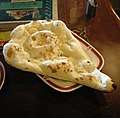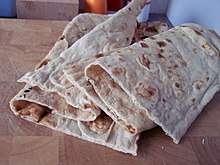Rumali roti
Rumali roti also called Manda is a thin flatbread originating from the Indian subcontinent, popular in India and in Punjab, Pakistan. It is eaten with tandoori dishes. The word rumal means handkerchief in many north Indian languages, and the name rumali roti means handkerchief bread. In Punjab, it is also known as lamboo roti. Lamboo simply means long in Punjabi. It is also known as dosti roti in the Caribbean.
 A stack of Rumali roti prepared in India | |
| Alternative names | Roomali roti, lamboo roti |
|---|---|
| Place of origin | Deccan, India |
| Region or state | Hyderabad, India |
| Associated national cuisine | India, Bangladesh, Pakistan |
| Main ingredients | Atta and maida flour |
| Variations | Paasti, Paosti |
This bread is extremely thin and limp, and served folded like a handkerchief. During the Mughal period, Rumali roti was used as a cloth to wipe the grease off the hands at the end of a rich meal.
Rumali is usually made with a combination of whole wheat atta flour and white wheaten maida flour and cooked on the convex side of a karahi.
A variation of rumali roti from Bannu and surrounding areas of Waziristan is a much larger version called paasti or paosti chappatai, which means soft chappati. They are served as part of a meal known as penda, (Punjabi: پینډه) usually prepared for a large gathering. Paosti is baked on a batt, which is a 55-gallon drum split in half length-wise and inverted over coal or wood fire.[1]
History
In the late Buddhist period, Mandaka, today called mande or manda or puran poli was a large paratha bread stuffed with sweetened pulse paste and baked on an inverted pot.[2] Rumali roti is its plain version.
 A chef preparing Rumali roti
A chef preparing Rumali roti Rumali roti
Rumali roti
References
- Mehran. "Mehran Posti". Haji Kalay: themehru.
- Achaya K. T. (1994). "Indian Food Tradition A Historical Companion". Retrieved 31 January 2019.



